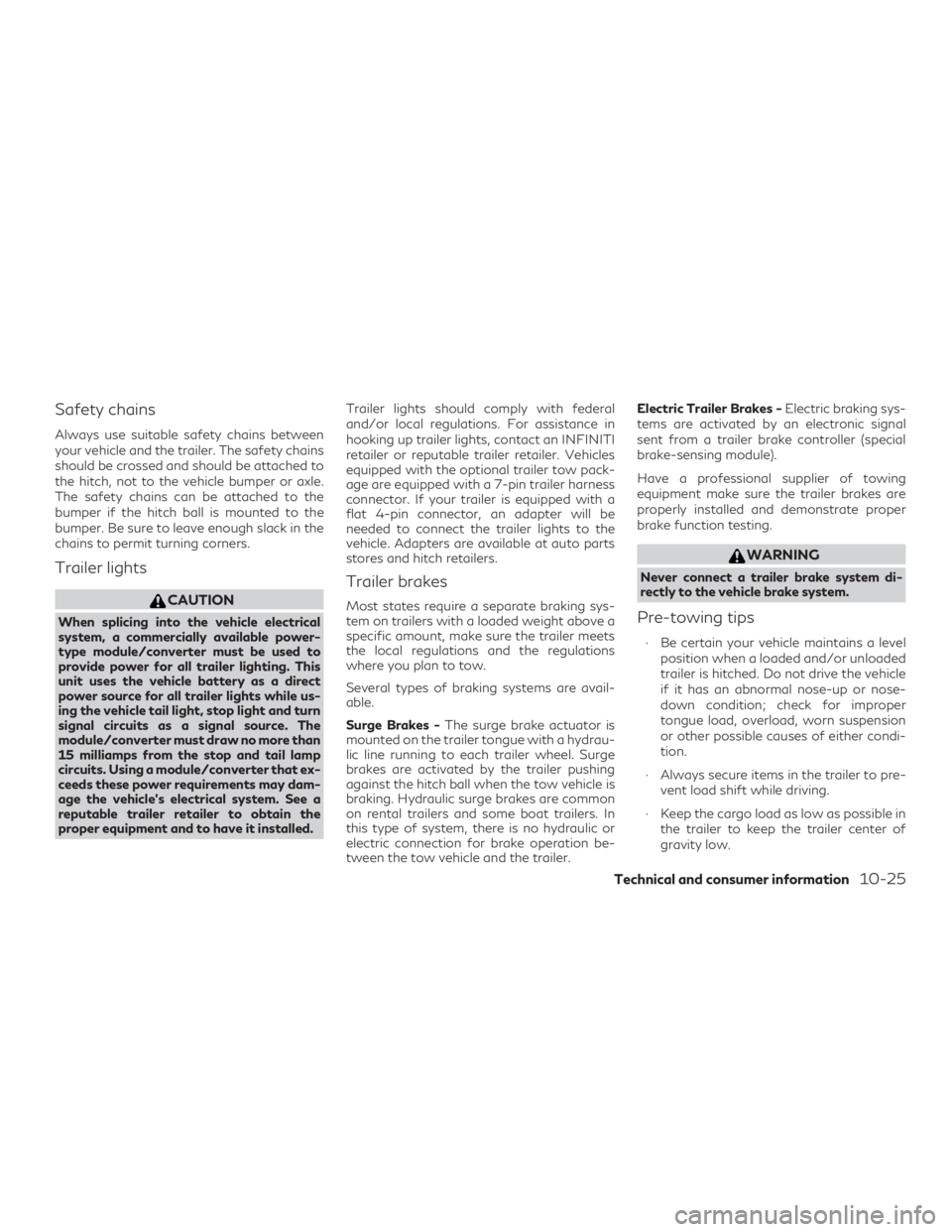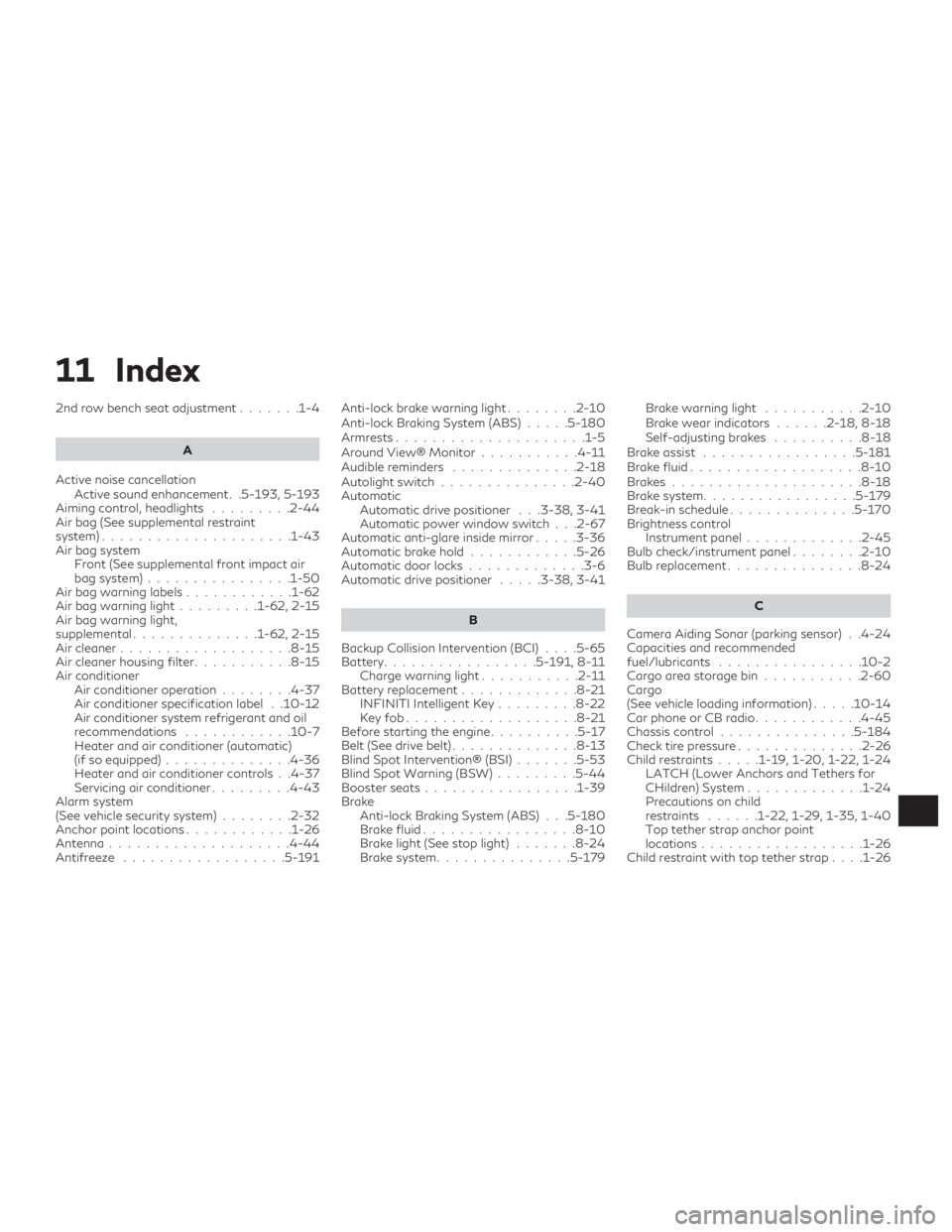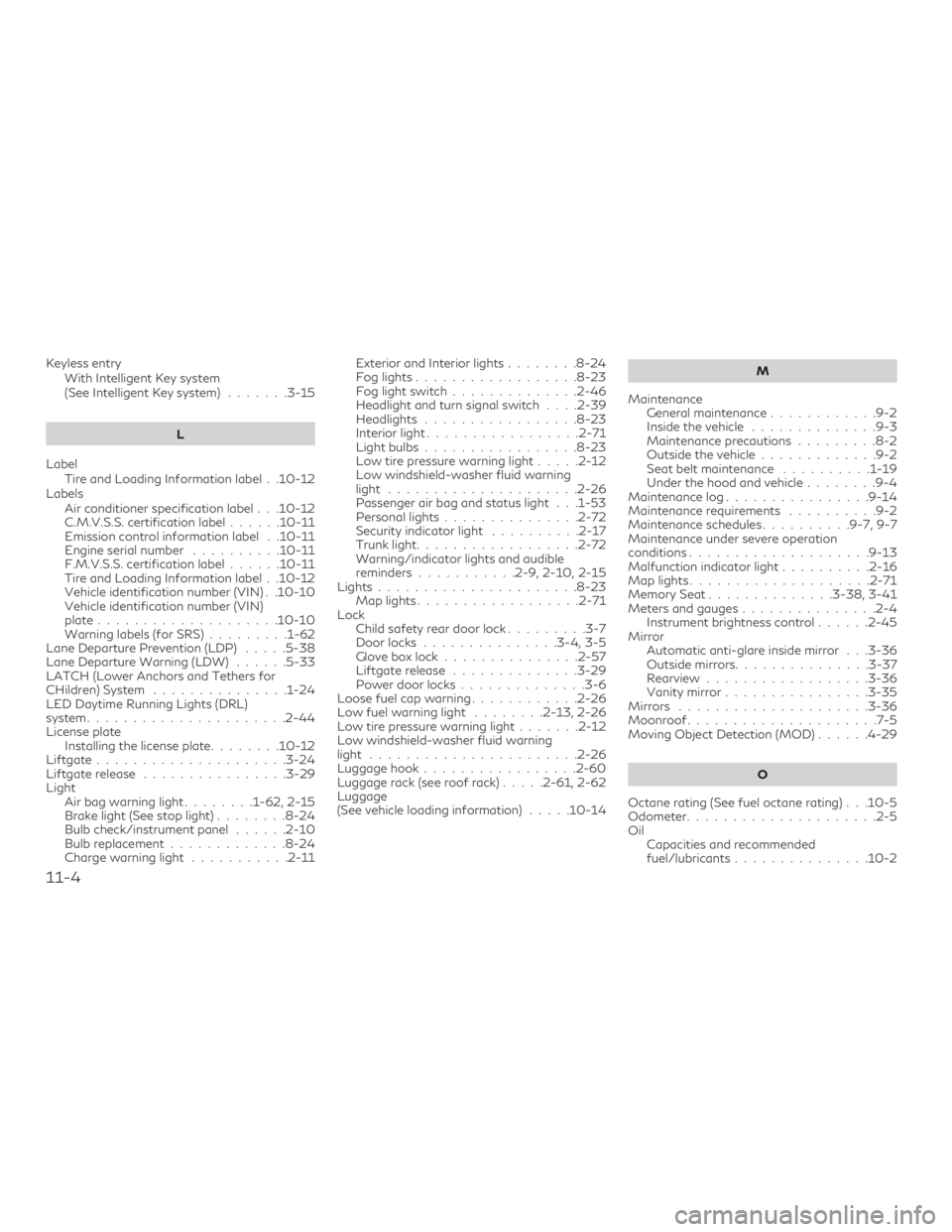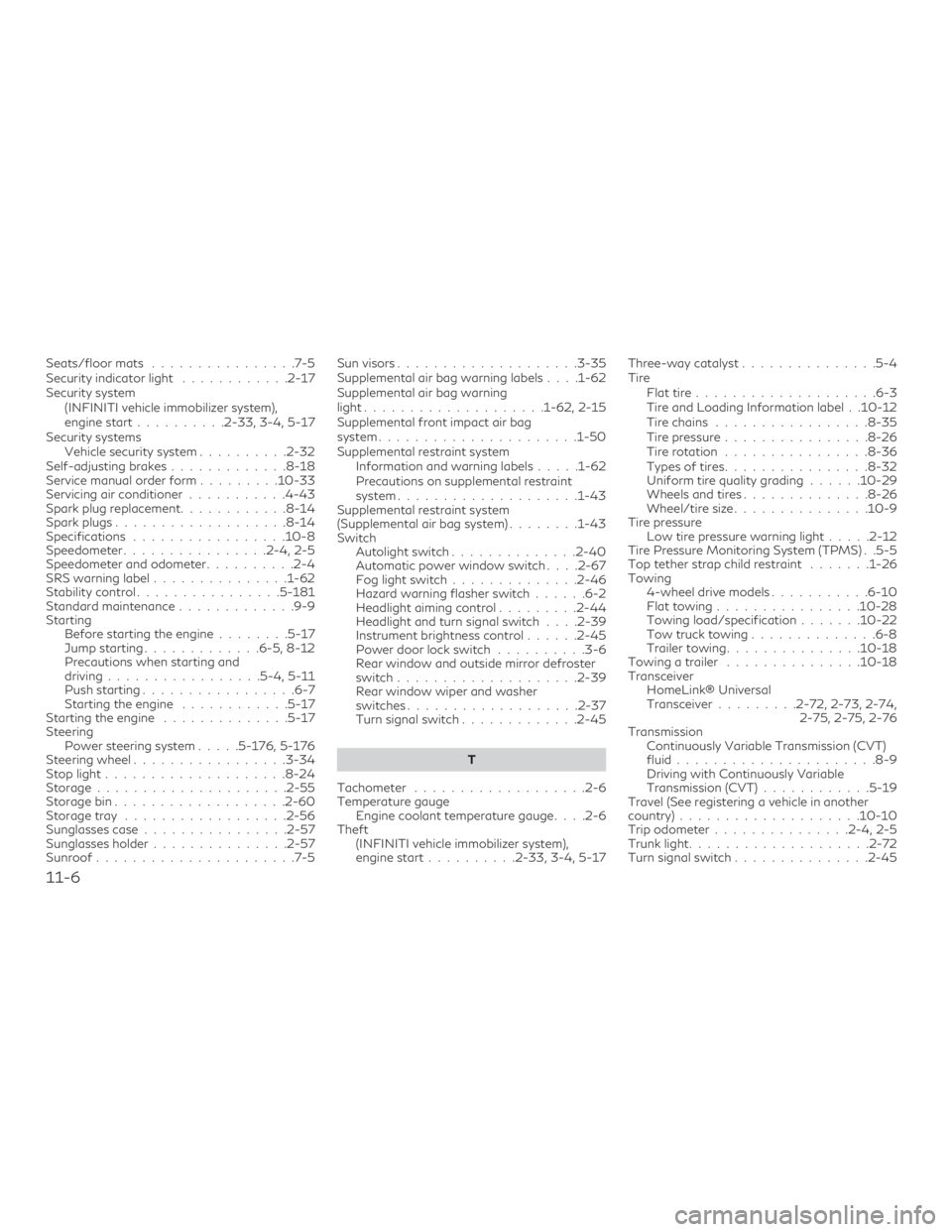ECU INFINITI QX50 2019 Manual PDF
[x] Cancel search | Manufacturer: INFINITI, Model Year: 2019, Model line: QX50, Model: INFINITI QX50 2019Pages: 573, PDF Size: 7.4 MB
Page 528 of 573

10 Technical and consumer information
Recommended fluids/lubricants and capacities . . 10-2Fuel recommendation ....................... 10-3
Engine oil and oil filter recommendations .....10-6
Air conditioner system refrigerant and oil
recommendations ........................... 10-7
Specifications .................................. 10-8
Engine ...................................... 10-8
Wheels and tires ............................ 10-9
Dimensions and weights .....................10-9
When traveling or registering in another
country ....................................... 10-10
Vehicle identification .......................... 10-10
Vehicle Identification Number (VIN) plate . . . 10-10
Vehicle identification number
(chassis number) ........................... 10-10
Engine serial number ....................... 10-11
F.M.V.S.S./C.M.V.S.S. certification label .....10-11
Emission control information label ..........10-11
Tire and Loading Information label ..........10-12
Air conditioner specification label ...........10-12
Installing front license plate ....................10-12Vehicle loading information
....................10-14
Terms ..................................... 10-14
Vehicle load capacity ....................... 10-15
Securing the load ........................... 10-16
Loading tips ............................... 10-17
Measurement of weights ...................10-17
Towing a trailer ............................... 10-18
Maximum load limits ....................... 10-19
Towing load/specification ..................10-22
Towing safety ............................. 10-23
Flat towing for front wheel drive vehicle
(if so equipped) ............................. 10-28
Flat towing for all–wheel drive vehicle
(if so equipped) ............................. 10-28
Uniform tire quality grading ....................10-29
Emission control system warranty .............10-30
Reporting safety defects ......................10-30
Readiness for Inspection/Maintenance (I/M)
test ........................................... 10-31
Event DataRecorders
(EDR)................... 10-32
Owner’s Manual/Service Manual order
information ................................... 10-33
Page 543 of 573

Steps for determining correct load
limit
1. Locate the statement “The com-bined weight of occupants and
cargo should never exceed XXX
lbs. or XXX kg” on your vehicle’s
Tire and Loading Information la-
bel.
2. Determine the combined weight of the driver and passengers that
will be riding in your vehicle.
3. Subtract the combined weight of the driver and passengers from
XXX lbs. or XXX kg.
4. The resulting figure equals the available amount of cargo and
luggage load capacity. For ex-
ample, if the XXX amount equals
1,400 lbs. and there will be five
150 lbs. passengers in your ve-
hicle, the amount of available
cargo and luggage load capacity
is 650 lbs. (1,400-750 (5 X 150)
= 650 lbs.) or (640-340 (5 X 70) =
300 kg.) 5. Determine the combined weight
of luggage and cargo being
loaded on the vehicle. That
weight may not safely exceed the
available cargo and luggage load
capacity calculated in step 4.
6. If your vehicle will be towing a trailer, load from your trailer will
be transferred to your vehicle.
Consult this manual to determine
how this reduces the available
cargo and luggage load capacity
of your vehicle.
Before driving a loaded vehicle, con-
firm that you do not exceed the GVWR
or the GAWR for your vehicle. For ad-
ditional information, refer to “Mea-
surement of weights” in this section.
Also check tires for proper inflation
pressures. For additional information,
refer to “Tire and Loading Information
label” in the “Do-it-yourself” section of
this manual.
SECURING THE LOAD
There are luggage hooks located in the cargo
area as shown. The hooks can be used to
secure cargo with ropes or other types of
straps.
When securing items using luggage hooks
located on the side finisher do not apply a
load over more than 6.5 lbs. (29 N) to a single
hook.
The luggage hooks that are located on the
floor should have loads less than 110 lbs.
(490 N) to a single hook.
Cargo area luggage hooks
LTI2331
10-16Technical and consumer information
Page 544 of 573

WARNING
∙ Properly secure all cargo with ropes orstraps to help prevent it from sliding or
shifting. Do not place cargo higher than
the seatbacks. In a sudden stop or colli-
sion, unsecured cargo could cause per-
sonal injury.
∙ The child restraint top tether strap may be damaged by contact with items in the
cargo area. Secure any items in the cargo
area. Your child could be seriously injured
or killed in a collision if the top tether
strap is damaged.
∙ Do not load your vehicle any heavier than the GVWR or the maximum front and
rear GAWRs. If you do, parts of your ve-
hicle can break, tire damage could occur,
or it can change the way your vehicle
handles. This could result in loss of con-
trol and cause personal injury.
LOADING TIPS
∙ The GVW must not exceed GVWR
or GAWR as specified on the
F.M.V.S.S./C.M.V.S.S. certifica-
tion label. ∙ Do not load the front and rear axle
to the GAWR. Doing so will exceed
the GVWR.
WARNING
∙ Properly secure all cargo with ropes or straps to help prevent it
from sliding or shifting. Do not
place cargo higher than the seat-
backs. In a sudden stop or collision,
unsecured cargo could cause per-
sonal injury.
∙ Do not load your vehicle any heavier than the GVWR or the
maximum front and rear GAWRs.
If you do, parts of your vehicle can
break, tire damage could occur, or
it can change the way your vehicle
handles. This could result in loss of
control and cause personal injury. ∙ Overloading not only can shorten
the life of your vehicle and the tire,
but can also cause unsafe vehicle
handling and longer braking dis-
tances. This may cause a prema-
ture tire failure which could result
in a serious accident and personal
injury. Failures caused by over-
loading are not covered by the ve-
hicle’s warranty.
MEASUREMENT OF WEIGHTS
Secure loose items to prevent weight
shifts that could affect the balance of
your vehicle. When the vehicle is
loaded, drive to a scale and weigh the
front and the rear wheels separately
to determine axle loads. Individual axle
loads should not exceed either of the
gross axle weight ratings (GAWR). The
total of the axle loads should not ex-
ceed the gross vehicle weight rating
(GVWR). These ratings are given on
the vehicle certification label. If weight
ratings are exceeded, move or remove
items to bring all weights below the
ratings.
Technical and consumer information10-17
Page 550 of 573

TOWING SAFETY
Trailer hitch
Your vehicle may be equipped with an op-
tional trailer tow package. The trailer tow
package includes a receiver-type frame
mounted hitch. This hitch is rated for the
maximum towing capacity of this vehicle
when the proper towing equipment is used.
Choose a proper ball mount and hitch ball
that is rated for the trailer to be towed. Genu-
ine INFINITI ball mounts and hitch balls are
available from an INFINITI retailer.
If your vehicle is not equipped with the op-
tional trailer tow package, check the towing
capacity of your bumper hitch or receiver-
type frame mounted hitch. Choose a proper
hitch for your vehicle and trailer. A Genuine
INFINITI trailer hitch is available from an
INFINITI retailer. Make sure the trailer hitch is
securely attached to the vehicle to help avoid
personal injury or property damage due to
sway caused by crosswinds, rough road sur-
faces or passing trucks.
WARNING
Trailer hitch components have specific
weight ratings. Your vehicle may be capable
of towing a trailer heavier than the weight
rating of the hitch components. Never ex-
ceed the weight rating of the hitch compo-
nents. Doing so can cause serious personal
injury or property damage.
Hitch ball
Choose a hitch ball of the proper size and
weight rating for your trailer:∙ The required hitch ball size is stamped on most trailer couplers. Most hitch balls
also have the size printed on the top of
the ball.
∙ Choose the proper class hitch ball based on the trailer weight.
∙ The diameter of the threaded shank of the hitch ball must be matched to the ball
mount hole diameter. The hitch ball shank
should be no more than 1/16” smaller
than the hole in the ball mount.
∙
The threaded shank of the hitch ball must
be long enough to be properly secured to
the ball mount. There should be at least 2
threads showing beyond the lock washer
and nut.
Ball mount
The hitch ball is attached to the ball mount
and the ball mount is inserted into the hitch
receiver. Choose a proper class ball mount
based on the trailer weight. Additionally, the
ball mount should be chosen to keep the
trailer tongue level with the ground.
Weight carrying hitches
A weight carrying or “dead weight” ball
mount is one that is designed to carry the
whole amount of tongue weight and gross
weight directly on the ball mount and on the
receiver.
Weight distribution hitch
This type of hitch is also called a “load-
leveling” or “equalizing” hitch. A set of bars
attach to the ball mount and to the trailer to
distribute the tongue weight (hitch weight) of
your trailer. Many vehicles can’t carry the full
tongue weight of a given trailer, and need
some of the tongue weight transferred
through the frame and pushing down on the
front wheels. This gives stability to the tow
vehicle.
A weight-distributing hitch system (Class IV)
is recommended if you plan to tow trailers
with a maximum weight over 5,000 lbs.
Technical and consumer information10-23
Page 552 of 573

Safety chains
Always use suitable safety chains between
your vehicle and the trailer. The safety chains
should be crossed and should be attached to
the hitch, not to the vehicle bumper or axle.
The safety chains can be attached to the
bumper if the hitch ball is mounted to the
bumper. Be sure to leave enough slack in the
chains to permit turning corners.
Trailer lights
CAUTION
When splicing into the vehicle electrical
system, a commercially available power-
type module/converter must be used to
provide power for all trailer lighting. This
unit uses the vehicle battery as a direct
power source for all trailer lights while us-
ing the vehicle tail light, stop light and turn
signal circuits as a signal source. The
module/converter must draw no more than
15 milliamps from the stop and tail lamp
circuits. Using a module/converter that ex-
ceeds these power requirements may dam-
age the vehicle’s electrical system. See a
reputable trailer retailer to obtain the
proper equipment and to have it installed.Trailer lights should comply with federal
and/or local regulations. For assistance in
hooking up trailer lights, contact an INFINITI
retailer or reputable trailer retailer. Vehicles
equipped with the optional trailer tow pack-
age are equipped with a 7-pin trailer harness
connector. If your trailer is equipped with a
flat 4-pin connector, an adapter will be
needed to connect the trailer lights to the
vehicle. Adapters are available at auto parts
stores and hitch retailers.
Trailer brakes
Most states require a separate braking sys-
tem on trailers with a loaded weight above a
specific amount, make sure the trailer meets
the local regulations and the regulations
where you plan to tow.
Several types of braking systems are avail-
able.
Surge Brakes -
The surge brake actuator is
mounted on the trailer tongue with a hydrau-
lic line running to each trailer wheel. Surge
brakes are activated by the trailer pushing
against the hitch ball when the tow vehicle is
braking. Hydraulic surge brakes are common
on rental trailers and some boat trailers. In
this type of system, there is no hydraulic or
electric connection for brake operation be-
tween the tow vehicle and the trailer. Electric Trailer Brakes -
Electric braking sys-
tems are activated by an electronic signal
sent from a trailer brake controller (special
brake-sensing module).
Have a professional supplier of towing
equipment make sure the trailer brakes are
properly installed and demonstrate proper
brake function testing.
WARNING
Never connect a trailer brake system di-
rectly to the vehicle brake system.
Pre-towing tips
∙ Be certain your vehicle maintains a level position when a loaded and/or unloaded
trailer is hitched. Do not drive the vehicle
if it has an abnormal nose-up or nose-
down condition; check for improper
tongue load, overload, worn suspension
or other possible causes of either condi-
tion.
∙ Always secure items in the trailer to pre- vent load shift while driving.
∙ Keep the cargo load as low as possible in the trailer to keep the trailer center of
gravity low.
Technical and consumer information10-25
Page 553 of 573

∙ Load the trailer so approximately 60% ofthe trailer load is in the front half and
40% is in the back half. Also make sure
the load is balanced side to side.
∙ Check your hitch, trailer tire pressure, ve- hicle tire pressure, trailer light operation,
and trailer wheel lug nuts every time you
attach a trailer to the vehicle.
∙ Be certain your rearview mirrors conform to all federal, state or local regulations. If
not, install any mirrors required for tow-
ing before driving the vehicle.
∙ Determine the overall height of the ve- hicle and trailer so the required clearance
is known.
Trailer towing tips
In order to gain skill and an understanding of
the vehicle’s behavior, you should practice
turning, stopping and backing up in an area
which is free from traffic. Steering stability
and braking performance will be somewhat
different than under normal driving condi-
tions.
∙ Always secure items in the trailer to pre- vent load shift while driving. ∙ Lock the trailer hitch coupler with a pin or
lock to prevent the coupler from inadver-
tently becoming unlatched.
∙ Avoid abrupt starts, acceleration or stops.
∙ Avoid sharp turns or lane changes.
∙ Always drive your vehicle at a moderate speed.
∙ When backing up, hold the bottom of the steering wheel with one hand. Move your
hand in the direction in which you want
the trailer to go. Make small corrections
and back up slowly. If possible, have
someone guide you when you are back-
ing up.
Always block the wheels on both vehicle and
trailer when parking. Parking on a slope is not
recommended; however, if you must do so:
CAUTION
If you move the shift selector to the P
(Park) position before blocking the wheels
and applying the parking brake, transmis-
sion damage could occur.
1. Apply and hold the brake pedal. 2. Have someone place blocks on the
downhill side of the vehicle and trailer
wheels.
3. After the wheel blocks are in place, slowly release the brake pedal until the
blocks absorb the vehicle load.
4. Apply the parking brake.
5. Shift the transmission into P (Park).
6. Turn off the engine.
To drive away: 1. Start the vehicle.
2. Apply and hold the brake pedal.
3. Shift the transmission into gear.
4. Release the parking brake.
5. Drive slowly until the vehicle and trailer are clear from the blocks.
6. Apply and hold the brake pedal.
7. Have someone retrieve and store the blocks.
10-26Technical and consumer information
Page 558 of 573

You may notify INFINITI by contacting
our Consumer Affairs Department,
toll-free, at 1-800-662-6200.
For Canada
If you believe that your vehicle has a
defect which could cause a crash or
could cause injury or death, you should
immediately inform Transport Canada
in addition to notifying INFINITI.
If Transport Canada receives com-
plaints, it may open an investigation,
and if it finds that a safety defect ex-
ists in a group of vehicles, it may re-
quest that INFINITI conduct a recall
campaign. However, Transport
Canada cannot become involved in in-
dividual problems between you, your
retailer, or INFINITI.
You may contact Transport Canada’s
Defect Investigations and Recalls Divi-
sion toll free at 1-800-333-0510. You
may also report safety defects online
at: https://wwwapps.tc.gc.ca/Saf-
Sec-Sur/7/PCDB-BDPP/fc-
cp.aspx?lang=eng (English speakers) orhttps://wwwapps.tc.gc.ca/Saf-Sec-
Sur/7/PCDB-BDPP/fc-
cp.aspx?lang=fra (French speakers)
Additional information concerning mo-
tor vehicle safety may be obtained from
Transport Canada’s Road Safety Infor-
mation Centre at 1-800-333-0371 or
online at www.tc.gc.ca/roadsafety
(English speakers) or www.tc.gc.ca/
securiteroutiere (French speakers).
To notify INFINITI of any safety con-
cerns please contact our Consumer In-
formation Centre toll free at 1-800-
361-4792.
WARNING
A vehicle equipped with All-Wheel Drive
(AWD) should never be tested using a two
wheel dynamometer (such as the dyna-
mometers used by some states for emis-
sions testing), or similar equipment. Make
sure you inform the test facility personnel
that your vehicle is equipped with AWD be-
fore it is placed on a dynamometer. Using
the wrong test equipment may result in
transmission damage or unexpected vehicle
movement which could result in serious ve-
hicle damage or personal injury.
Due to legal requirements in some states and
Canadian Provinces, your vehicle may be re-
quired to be in what is called the “ready con-
dition” for an Inspection/Maintenance (I/M)
test of the emission control system.
The vehicle is set to the “ready condition”
when it is driven through certain driving pat-
terns. Usually, the ready condition can be
obtained by ordinary usage of the vehicle.
If a powertrain system component is repaired
or the battery is disconnected, the vehicle
may be reset to a “not ready” condition. Be-
fore taking the I/M test, check the vehicle’s
inspection/maintenance test readiness con-
dition. Place the ignition switch in the ON
position without starting the engine. If the
READINESS FOR INSPECTION/
MAINTENANCE (I/M) TEST
Technical and consumer information10-31
Page 562 of 573

11 Index
2nd row bench seat adjustment.......1-4
A
Active noise cancellation Active sound enhancement . .5-193, 5-193
Aiming control, headlights .........2-44
Air bag (See supplemental restraint
system).....................1-43
Air bag system Front (See supplemental front impact air
bag system) ................1-50
Air bag warning labels ............1-62
Airbagwarninglight.........1-62,2-15
Air bag warning light,
supplemental ..............1-62,2-15
Air cleaner ...................8-15
Air cleaner housing filter ...........8-15
Air conditioner Air conditioner operation ........4-37
Air conditioner specification label . .10-12
Air conditioner system refrigerant and oil
recommendations ............10-7
Heater and air conditioner (automatic)
(if so equipped) ..............4-36
Heater and air conditioner controls . .4-37
Servicing air conditioner .........4-43
Alarm system
(See vehicle security system) ........2-32
Anchor point locations ............1-26
Antenna ....................4-44
Antifreeze ..................5-191 Anti-lock brake warning light
........2-10
Anti-lock Braking System (ABS) .....5-180
Armrests.....................1-5
Around View® Monitor ...........4-11
Audible reminders ..............2-18
Autolight switch ...............2-40
Automatic Automatic drive positioner . . .3-38, 3-41
Automatic power window switch . . .2-67
Automatic anti-glare inside mirror .....3-36
Automaticbrakehold ............5-26
Automatic door locks .............3-6
Automatic drive positioner .....3-38,3-41
B
Backup Collision Intervention (BCI) ....5-65
Battery.................5- 191, 8-11
Charge warning light ...........2-11
Battery replacement .............8-21
INFINITI Intelligent Key .........8-22
Keyfob...................8-21
Before starting the engine ..........5-17
Belt (See drive belt) ..............8-13
Blind Spot Intervention® (BSI) .......5-53
Blind Spot Warning (BSW) .........5-44
Boosterseats.................1-39
Brake Anti-lock Braking System (ABS) . . .5-180
Brakefluid.................8-10
Brakelight(Seestoplight) .......8-24
Brake system ...............5-179 Brakewarninglight ...........2-10
Brake wear indicators
......2-18,8-18
Self-adjusting brakes ..........8-18
Brakeassist .................5-181
Brakefluid...................8-10
Brakes.....................8-18
Brake system ................. 5-179
Break-in schedule ..............5-170
Brightness control Instrument panel .............2-45
Bulb check/instrument panel ........2-10
Bulb replacement ............... 8-24
C
Camera Aiding Sonar (parking sensor) . .4-24
Capacities and recommended
fuel/lubricants ................10-2
Cargoareastoragebin...........2-60
Cargo
(See vehicle loading information) .....10-14
Car phone or CB radio ............4-45
Chassis control ............... 5
-184
Check tire pressure .............. 2-26
Child restraints .....1-19,1-20, 1-22, 1-24
LATCH (Lower Anchors and Tethers for
CHildren) System .............1-24
Precautions on child
restraints ......1-22,1-29,1 -35, 1-40
Top tether strap anchor point
locations..................1-26
Child restraint with top tether strap ....1-26
Page 565 of 573

Keyless entryWith Intelligent Key system
(See Intelligent Key system) .......3-15
L
Label Tire and Loading Information label . .10-12
Labels Air conditioner specification label . . .10-12
C.M.V.S.S. certification label ......10-11
Emission control information label . .10-11
Engine serial number ..........10-11
F.M.V.S.S. certification label ......10-11
Tire and Loading Information label . .10-12
Vehicle identification number (VIN) . .10-10
Vehicle identification number (VIN)
plate....................10-10
Warning labels (for SRS) .........1-62
Lane Departure Prevention (LDP) .....5-38
Lane Departure Warning (LDW) ......5-33
LATCH (Lower Anchors and Tethers for
CHildren)System ...............1-24
LED Daytime Running Lights (DRL)
system......................2-44
License plate Installing the license plate ........10-12
Liftgate.....................3-24
Liftgaterelease ................3-29
Light Airbagwarninglight........1-62,2-15
Brakelight(Seestoplight)........8-24
Bulb check/instrument panel ......2-10
Bulb replacement .............8-24
Charge warning light ...........2-11 ExteriorandInteriorlights........8-24
Foglights..................8-23
Fog light switch
..............2-46
Headlight and turn signal switch ....2-39
Headlights .................8-23
Interiorlight.................2-71
Lightbulbs.................8-23
Low tire pressure warning light .....2-12
Low windshield-washer fluid warning
light .....................2-26
Passenger air bag and status light . . .1-53
Personal lights ...............2-72
Security indicator light ..........2-17
Trunklight..................2-72
Warning/indicator lights and audible
reminders ...........2-9,2-10,2-15
Lights......................8-23 Maplights..................2-71
Lock Child safety rear door lock .........3-7
Door locks ...............3-4,3-5
Gloveboxlock...............2-57
Liftgaterelease ..............3-29
Power door locks ..............3-6
Loose fuel cap warning ............2-26
Lowfuelwarninglight ........2-13,2-26
Low tire pressure warning light .......2-12
Low windshield-washer fluid warning
light .......................2-26
Luggage hook .................2-60
Luggage rack (see roof rack) .....2-61,2-62
Luggage
(See vehicle loading information) .....10-14 M
Maintenance Generalmaintenance............9-2
Inside the vehicle ..............9-3
Maintenance precautions .........8-2
Outside the vehicle .............9-2
Seat belt maintenance ..........1-19
Under the hood and vehicle ........9-4
Maintenance log ................ 9-14
Maintenance requirements ..........9-2
Maintenance schedules ..........9-7, 9-7
Maintenance under severe operation
conditions....................9-13
Malfunctionindicatorlight..........2-16
Maplights.................... 2-71
Memory Seat ..............3-38,3-41
Meters and gauges ...............2-4
Instrument brightness control ......2-45
Mirror Automatic anti-glare inside mirror . . .3-36
Outside mirrors ...............3-37
Rearview ..................3-36
Vanity mirror ................3-35
Mirrors .....................3-36
Moonroof .....................
7-
5
Moving Object Detection (MOD) ......4-29
O
Octane rating (See fuel octane rating) . . .10-5
Odometer .....................2-5
Oil Capacities and recommended
fuel/lubricants............... 10-2
11-4
Page 567 of 573

Seats/floor mats................7-5
Security indicator light ............2-17
Security system (INFINITI vehicle immobilizer system),
engine start ..........2-33,3-4,5-17
Security systems Vehicle security system ..........2-32
Self-adjusting brakes .............8-18
Service manual order form .........10-33
Servicing air conditioner ...........4-43
Spark plug replacement ............8-14
Spark plugs ...................8-14
Specifications .................10-8
Speedometer ................2-4,2-5
Speedometer and odometer ..........2-4
SRS warning label ...............1-62
Stability control ................5-181
Standard maintenance .............9-9
Starting Before starting the engine ........5-17
Jump starting .............6-5,8-12
Precautions when starting and
driving .................5-4,5-11
Push starting .................6-7
Starting the engine ............5-17
Starting the engine ..............5-17
Steering Power steering system .....5-176, 5-176
Steering wheel .................3-34
Stoplight....................8-24
Storage.....................2-55
Storagebin...................2-60
Storagetray ..................2-56
Sunglasses case ................2-57
Sunglasses holder ...............2-57
Sunroof ......................7-5 Sun visors
....................3-35
Supplemental air bag warning labels ....1-62
Supplemental air bag warning
light....................1-62,2-15
Supplemental front impact air bag
system......................1-50
Supplemental restraint system Informationandwarninglabels.....1-62
Precautions on supplemental restraint
system ....................1-43
Supplemental restraint system
(Supplemental air bag system) ........1-43
Switch Autolight switch ..............2-40
Automatic power window switch ....2-67
Fog light switch ..............2-46
Hazard warning flasher switch ......6-2
Headlight aiming control .........2-44
Headlight and turn signal switch ....2-39
Instrument brightness control ......2-45
Power door lock switch ..........3-6
Rear window and outside mirror defroster
switch....................2-39
Rear window wiper and washer
switches ...................2-37
Turn signal switch .............2-45
T
Tachometer ...................2-6
Temperature gauge Engine coolant temperature gauge ....2-6
Theft (INFINITI vehicle immobilizer system),
engine start ..........2-33,3-4,5-17 Three-way catalyst
...............5-4
Tire Flat tire ....................6-3
Tire and Loading Information label . .10-12
Tire chains ................. 8
-35
Tirepressure................8-26
Tirerotation ................8-36
Types of tires ................8-32
Uniform tire quality grading ......10-29
Wheels and tires .............. 8-26
Wheel/tire size ...............10-9
Tire pressure Low tire pressure warning light .....2-12
Tire Pressure Monitoring System (TPMS) . .5-5
Top tether strap child restraint .......1-26
Towing 4-wheel drive models ...........6-10
Flattowing................10-28
Towing load/specification .......10-22
Towtrucktowing..............6-8
Trailertowing...............10-18
Towing a trailer ...............10-18
Transceiver HomeLink® Universal
Transceiver......... 2-72, 2-73, 2-74,
2-75, 2-75, 2-76
Transmission Continuously Variable Transmission (CVT)
fluid......................8-9
Driving with Continuously Variable
Transmission (CVT) ............5-19
Travel (See registering a vehicle in another
country) ....................10-10
Trip odometer ...............2-4,2-5
Trunklight.................... 2-72
Turn signal switch ............... 2-45
11-6